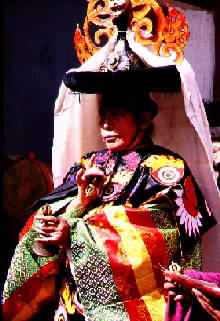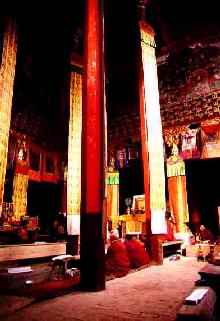"Where did all these monks come from?" I ask Tenzeng Nyima, manager of Baiya Monastery. There are, literally, dozens of unfamiliar faces in the monastery. This is my eighth visit to Baiya, and I thought I knew everyone by now, but suddenly I am hard put to find even one familiar face. He replies: "Palpung, Dzongsar, Gonchhen"--names of major monasteries in Dege County.
The draw is, obviously, Baiya Rinpoche's long-awaited and triumphant return to his traditional seat after an absence of four years or more. Despite his 65 years and frail constitution, he came from Chengdu at double-quick pace, today traveling 12 hours on punishing dirt roads.
Baiya Rinpoche Temple with murals (upper part of photo)
rescued by KAF team.I joined him for the final leg: four hours from the Dege County seat to Baiya. I know the route well, although it has changed greatly. During the last two years workers armed with picks, shovels, and dynamite hacked a motorable road out of earth and stone, obliterating what had once been a peaceful trail along the Beichhu River. Our headlights illuminated huge piles of logs, corpses of the vanquished wilderness. It was a distressing sight. Yet sadness fled as our jeep surged up that final, oh-so-familiar hill, and squeezed through the courtyard gate.
Today is the sixth day of the ninth moon, the start of the Thugdrab Tagen religious festival, and Baiya Rinpoche has been anxiously expected. The village has no telephone, and I remember very well what it's like to be waiting for someone dear when you have no way of receiving any tidings of them. Joyful monks swarm about the jeep, jousting for the honor of carrying his baggage. The exhausted Rinpoche is rushed like an intensive care patient into a waiting chamber upstairs.
The next morning, rather late, they get started on the ceremony. Tenzeng Nyima had been busy for weeks, directing monks in the preparations. The temple is hung with silk banners and thankas. Trays of torma (dough sculpture) have been created, decorated with psychedelic floral shapes formed from colored butter, and laid out awaiting use. In the temple, cushions and low tables are arranged in rows. Visitors have been assigned lodging within the monastery and neighboring houses. Firewood is stocked, and the monastery's huge pots made ready to cook barley porridge and butter tea. Countless objects needed for the ceremony have been found, unpacked, and prepared: red coxcomb headdresses, amphorae and chalices, butter lamps and offering bowls, silk parasols, ceremonial platforms, scarves of colored silk, drums, bells, and cymbals. Juniper has been gathered; the smoke of its burning branches now waft to the sky, purifying the air. The monastery's generator, brought to Baiya by my conservation team in 1995, is gassed up, and lights hang in the main temple. On the floor of the Rinpoche's chamber they laid clean linoleum--another relic of the art conservation work.
I watch all of this unfamiliar activity, and think: we've given it back. Baiya Monastery belongs to the monks now. The transient foreign incongruities of women, cleanliness, voices in Chinese, English and Italian, vegetables and wine on the dinner table, badminton in the courtyard, and nighttime songs have all vanished. The place is swarming with red robes. Tsampa, yak meat, droju (dough fritters), and butter tea are the main menu, the only menu. Thermoses are crusted with dirt. In a corner of my room--and I'm grateful that they saved it for me--I recognize litter from my last visit; it has not been swept since then. What was once our storage room for conservation materials is now full of beds and monks. We saved the monastery. Now they are putting it to use.
In the main temple, Baiya Rinpoche presides over 34 chanting lamas. One of them is young Trajia, who learned art conservation from the foreign experts I brought to Baiya. Now he is wearing the burgundy robes and golden singlet of his primary vocation, suddenly all grown up. Most of my other monk friends are backstage managing the nuts and bolts of the complicated ten-day ritual that has just started.
On his high throne, Baiya Rinpoche seems not so much a god, but a doctor managing a team of spiritual surgeons. He knows just what to do and when to do it, a consummate pro at making the mudras, pouring the water, flicking the grains. When he stands, monks are there to ease his old legs up from their cross-legged posture, and they stay at his elbows as he descends the wooden steps. Leading a line of grandly attired lamas, Baiya Rinpoche paces a solemn circle about a platform loaded with sacred objects. He chants, circles, rings his bell, and nudges the young traba next to him who has missed a cue. When this part is finished, Baiya Rinpoche returns to his throne, collapses into a sitting posture with a whump, then arranges his robes decorously. It's going to be a long day of hard work.
Above it all, in the temple's high lantern, painted figures stand watching. These are the murals that expert foreign conservators Donatella Zari, Carlo Giantomassi, Guido Botticelli, Paola Azzaretti, and Karen Yager saved in a program of conservation that started in 1995 and ended in May of this year. Seeing them now, unfurled in all their colorful glory, my heart sings and a tear comes to my eye.
The murals had been attached to buckling clay walls, and were further threatened by impending collapse of the roof above. With the help of half a dozen Tibetan apprentices, the experts detached these murals, pulling them right off the wall in a delicate process that took almost a month. Then local engineer Shongshong rebuilt the walls and roof . In April, 1998 the experts came back for another month-long mission. They applied a fiberglass backing to the murals, removed the gauze facing, and made them ready to be reattached. Our student, young Trajia, oversaw the final step of aligning the murals on the new walls that Shongshong built.
I emerge from the temple, and wander the neighborhood of the monastery. Nearby, a new temple is going up, paid for with money Baiya Rinpoche raised during recent travels abroad. As I go about the village, on every footpath I see familiar faces like memories materialized into flesh and blood: the funny old monk Tsetra who swept our rooms and brought our hot water; the hardworking monk Nyima; Tashi Dendrup the carpenter; Palden the painter; some women from the neighborhood who look so alike they must be sisters; scores of runny-nosed children. Kunchab, the hopeless monk apprentice who so exasperated Carlo and Donatella in 1995 is now filled out, majestic in the finery of a high lama. The villagers all seem to know who I am. They call me "Luobai," the name that Shongshong uses, an unauthorized abbreviation of my Chinese name. They say it, and smile, and open their upturned hands in a Tibetan gesture of respect and greeting.
This time my stay will be short. But I am a part of this place; they will always welcome me back home to Baiya Monastery.

